A half-hour into my stroll up Archer Avenue I noticed a car speeding by with a big red-and-white Polish flag taped to its hood, then a second one with a flag sticking out a window, then a third with a couple of flags attached to the roof. Something was going on.
Archer, which runs 10 miles northeast through Chicago's South Side, from the suburban border to Chinatown, was the latest foray in my campaign to walk the length of all the city's major thoroughfares. Years ago I tackled Milwaukee and Western avenues; last December my friend Kevin Monahan and I conquered all 20 miles of Halsted Street in one long, frigid, alcohol-soaked day.
I'm not sure why I chose Archer Avenue this time, except I wanted to check out all the the cool post-war artifacts, ethnic restaurants and dive bars I'd seen on rides to the Baby Doll Polka Club and while doing fieldwork for the City's bike program.
Archer follows the original portage path from the Des Plaines River to the Chicago River, basically the same trail that French explorers Marquette and Joliet used to carry their canoes when they first mapped out the Illinois region in 1673. The street parallels the route of the old Illinois and Michigan Canal, the Sanitary and Ship Canal (responsible for reversing the flow of the Chicago River) and I-55, the Adelai Stevenson Expressway.
According to Streetwise Chicago by Don Hayner and Tom McNamee (Loyola University Press 1988), Archer Avenue was named for Col. William Beatty Archer, a civil engineer and abolitionist. In the mid-1800s Irish immigrants who settled in the Bridgeport neighborhood, near the northern terminus of the street, disliked the colonel for his politics — they worried that freed slaves would compete with them for jobs. But after Archer became head of the I & M Canal Commission and provided them with hundreds of jobs building the waterway, he became a popular man in Bridgeport.
On Saturday, May 3, I boarded the Blue Line in Wicker Park solo — I'd invited a bunch of my pals to join me but this time no one took the bait. I rode southeast to the Loop and then west to the Harlem stop, then caught a Pace bus south a few miles to the suburb of Summit, where Archer crosses the border.
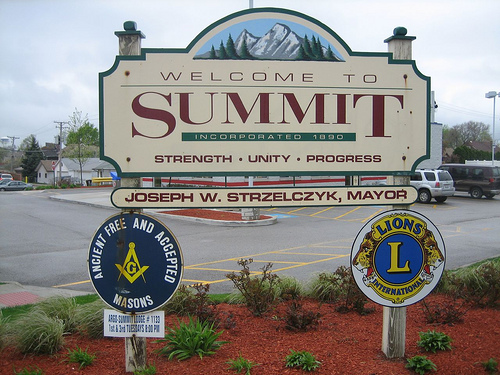
I continued another two blocks south to Chicagoland's first Krispy Kreme location. Ten years ago, when this was the only place in the area to buy their doughnuts, I used make regular pilgrimages there to get them as they rolled hot off the line. I was looking forward to starting my walk with a Boston cream, so I was bitterly disappointed when I saw "STORE NOW CLOSED" signs in the windoWest Now that you can find Krispy Kremes in any Jewel supermarket, the shop had lost its cachet. Like someone who had eated too many of the oil-laden fritters, it was a victim of saturation.
It was a dismal, chilly day with light rain and a brisk wind blowing (fortunately for me) out of the southwest. Pulling the hood of my raincoat over my head I backtracked to Archer and started my trek east into Chicago's Garfield Ridge neighborhood at 3:30pm. At this point the road was essentially 55th Street, heading due east at 5500 south; it would begin its northeasterly slope a mile later.
In a few minutes I found myself outside the Rainbow Motel, 7050 West, which is famous for for its Pink Palace Suites, available for four- and six-hour visits as well as overnight stays. Eleven "Fantasy Rooms" offer marble whirlpool spas and complimentary champagne in unque theme settings. The "Hawaiian Waters" room includes an octagonal waterbed and tiki décor; "Space Walk" has a bed shaped like a lunar lander, surrounded by stars, planets and "friendly spaceships"; "Out to Lunch" features a bed shaped like a giant sandwich.
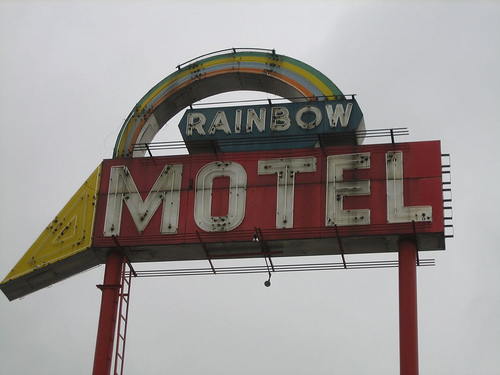
"It's a year-round paradise and a dream fantasy vacation," explains a brochure. "A couple's place to get re-acquainted with the one you love, celebrate life with the one you married or begin a new, exciting relationship."
After grabbing a prune kolacky across the street at Weber's, 7055 West, one of dozens of old-school bakeries I'd pass that day, I continued east. Here, and for most of its length, Archer is a four-lane road with high-speed traffic and parking on either side. Yellow Submarine, 6825 West, a drive-in with postmodern, boat-like architecture looked folorn, boarded-up and abandoned.
On the other hand, Carmen's Bicycles, 6519 West, is a cheerful outpost almost 10 miles from the nearest Chicago bike shop. It was closed but behind the security lattice man-sized Elmo and Kermit the Frog dolls were visible, sharing the seat of a classic Schwinn cruiser.
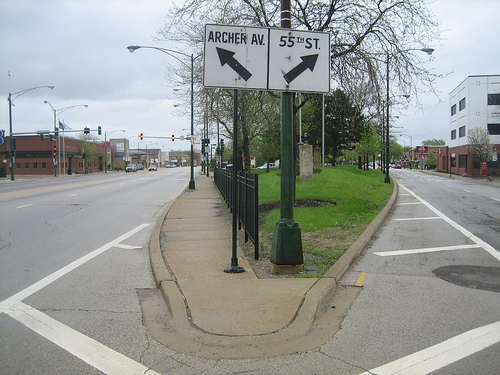
At Narragansett St. (6400 West), Archer veered a bit northward, splitting from 55th at a small triangular park where a granite slab honored the freedom fighter Lech Walesa and his Solidarity movement. Soon I began noticing the vehicles with red-and-white flags and realized the residents of this heavily Polish area must be celebrating something.
As a jet soared right over my head I remembered that I was only a few blocks from Midway Airport. Hungry, I soon ducked into Stan and Helene's (5960 West), a run-down bar that advertised home cooking in English and Polish. "Is this some kind of Polish-American holiday?" I asked the bartender as she drew me an MGD. "Yes, it's Polish Constitution Day," she replied in a pleasing Slavic accent.

I ordered some tasty potato pancakes with chunky applesauce and a side of smoked sausage and leaned back in my barstool to watch the Kentucky Derby on TV as "Mississippi Queen" blared on the jukebox. Next to me a very drunk couple caroused over mini pitchers. After the woman finished slicing her sandwich the barmaid demanded, "Give me the knife."
In a few blocks I passed Bobak Sausage Company, 5275 South, a giant sausage store and then came to Szata's restaurant, 5220 South, a huge A-frame building with evergreens and an old-fashioned carriage in front. The sign featured a cartoon of a burley Polish Highlander pouring himself a mug from a giant beer keg hoisted on his shoulder.
A second triangular park at Archer and 51st features an artillery gun and small memorials to the Korean and Vietnam wars. Gazing at them, it occurred to me that the Korean War was probably worth fighting — South Korea is now a rich country while the people of North Korean often face food shortages under one of the world's most oppressive regimes. If things had gone similarly in Vietnam, that war would not have seemed like such a collosal mistake.
I spied the Orange Line station at Pulaski Avenue, 4000 West, where Archer takes on a steeper pitch, heading almost due northeast. More Spanish-language signs began to appear among the Polish delis. The sign for La Femme Chicago Chic Boutique, 5093 South, shows a Patrick Nagel-inspired beauty, straight off the cover of a Duran Duran album, while glazed terra cotta tiles outside Szykowny Funeral Home, 4901 South, form a delicate rhododendron motif.

I stopped for a,other beer at the headquarters for the Polish Highlanders of America, 4808 South, a large complex with a restaurant, bar and banquet facilities. A group of Latino folks were entering the rental hall for some sort of celebration; a few of them were wearing cowboy clothes. Inside the tavern with its beautiful blond woodwork I heard only Polish as I sipped a big mug of Okocim.
An older gentleman next to me was dressed in white leggings and a vest. When I asked him if he was part of some kind of Constitution Day performance, someone explained that the guy didn't speak any English. "It's old-school, traditional Highlander gear," explained a young guy with a red-and-white Dr. Suess hat emblazoned with the Polish eagle on the bar in front of him. "It's kind of like mariarchi to a Mexican." Soon a quartet in a corner booth, including a young man in 1800s military clothing, began bellowing Polish drinking songs at an earsplitting volume.
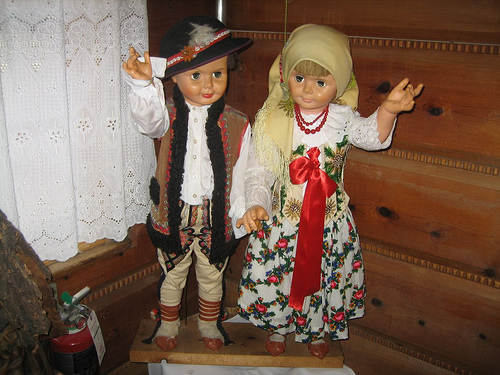
Moving along, I passed the World's Finest Chocolate factory, 4801 South, Show Carpet Outlet, 4327 South, with a garish Pirates of the Carribean-inspired mural painted on the side wall, and the classic Golden Heart Snack Shop, 4210 South.
At Tenoch Tattoo, 3970 South, young people were painting Pre-Columbian Mexican art designs on the walls, ceiling and floor, as well as a huge portrait of Kika, the owner. Jesus Barrios, the manager, explained that the shop is named after the legendary ruler of the Aztecs who founded Mexico City, AKA Tenochtitlan.
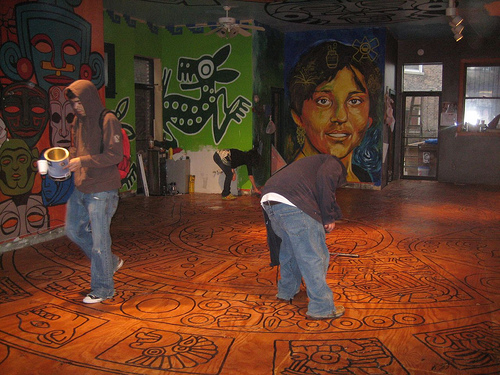
As the sun peeked out from the clouds I stopped at lush, green McKinley Park, 3700 South, one of Chicago's three major parks named after assassinated U.S. presidents, to check out a statue of its namesake. Commander in chief during the Spanish-American War, in which the U.S. won control of Puerto Rico, Cuba, the Phillipines and Guam, William McKinley was shot by the anarchist Leon Czolgosz in 1901.
A few blocks later, I stopped at the windowless, triangular bar El Toro Loco for my third beer of the day. The place seemed a bit sketchy from the outside, but inside clean white walls and a large mirror created a pleasantly spacious effect. At 7 pm the place was empty except for a small group of attractive young and middle-aged women chatting in Spanish with the barmaid and a single man drinking alone at the other end of the bar. Conjunto music played on the sound system and a Mexican talk show was on TV. As I reached the bottom of my can of Tecate someone came in with a bag of limes and I was offered a slice for my beer — too late.
At Damen Avenue I saw Huck Finn Donuts, a 24-hour diner I used to frequent when I lived nearby in Bridgeport a decade ago. Half a block north I noticed La Palapa, 2000 W. 34th, a new seafood shack topped with a giant fibreglass shark, and couldn't resist stopping in. I'd been planning to have dinner in Chinatown, but the shrimp-and-octopus cocktail I ordered came in a goblet the size of a goldfish bowl. It was one of the best things I've eaten in a while — packed with big pieces of seafood in a sweet tomato base with onion, cilantro and hunks of avocado, plus sides of ceviche (pickled fish), green salsa, crisp corn tortillas and Saltines.
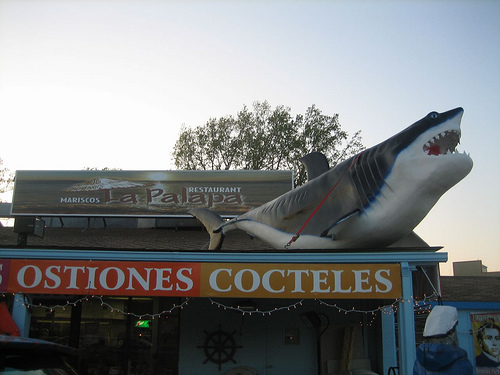
Things became less scenic and my feet grew tired as I strolled away from the sunset into Bridgeport, with dull stretches of industry and cookie-cutter townhomes. At Ashland the Stevenson Expressway joined up with Archer and formed the view on my left. But as I passed the storefront Chicago Shaolin Temple, 2990 South, a view of senior citizens doing tai chi lifted my spirits.
Bike lanes were visible for the first time on Archer around 27th, shortly before the street parted ways with the expressway. I didn't notice any artifacts of Bridgeport's Irish past, but as I neared Chinatown I saw more signs in Chinese and a few Asian food manufacturing plants, like New Taste Good Noodles Co., 2559 South.
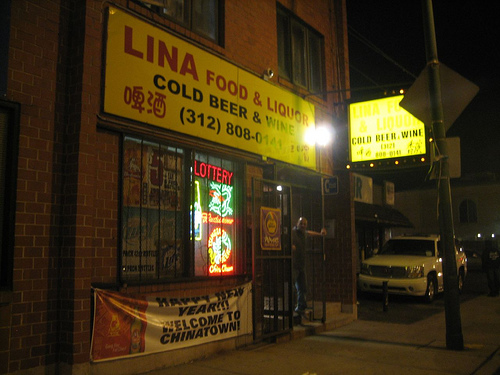
As I entered the Chinese neighborhood, I stopped to snap a picture of Lina Food and Liquor, near Cermak, with its neon Chinese dragon beer signs. The clerk came out and scolded me. "What are you doing? You're supposed to ask permission before you do that." "Whatever," I said, rolling my eyes, and walked away.
I was pretty sick of walking by then but the old-fashioned signage, festive lights and interesting architecture of Chinatown always cheer me up when I'm in a funk. I passed by the Chinatown Mall on the northwest side of Archer, where the locals tend to eat, away from the more touristy main drags of Cermak and Wentworth. The mall's plaza is populated with large stone sculptures of temple dogs and others animals from the Chinese Zodiac. Up the block, a large mosaic shows the history of Chinese immigration to the U.S. In the center of the image, for some reason, figures of various ethnicites in office clothes stand under the Statue of Liberty.
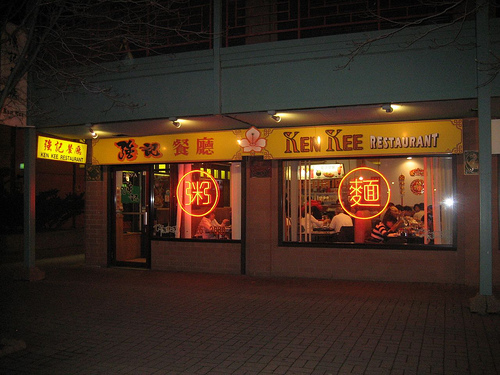
I had only a couple more blocks to walk as I spotted the Hilliard Homes, curving, honeycombed towers designed by Bertrand Goldberg, the same architect who did the twin corncobs of the Loop's Marina City complex. Originally a high-rise public housing project, the homes have recently been converted into mixed-income apartments.
As I reached the northern terminus of Archer at State Street, Chicago's east-west bifurcator, on my right I saw the dull, new Pointe 1900 Residences. But on my left stood the inspiring architecture of Perspectives Charter School, a dramatic, angular steel-and-glass structure that resembled the prow of a ship. It seemed like a cool school.
I backtracked to Chinatown, bought a coconut bun at a bakery and headed to catch a ride home at the local Red Line station, next to an expressway exit ramp near Cermak and Wentworth. A week earlier during Friday evening rush hour, a semi truck barreled off the ramp through the intersection and slammed into the escalator at the north entrance of the crowded station, killing two riders and injuring many others. As I write this, the 64-year-old driver is still in police custody while authorities try to determine what happed.
The north entrance had reopened the day before I walked Archer. The CTA had done a good job of cleaning up what had been a mass of wreckage. On top of the clean, white board-up area, a bilingual banner with Chinese characters and English words in reassuring Helvetica font informed customers that escalator replacement was underway. "We appreciate your patience." ✶






